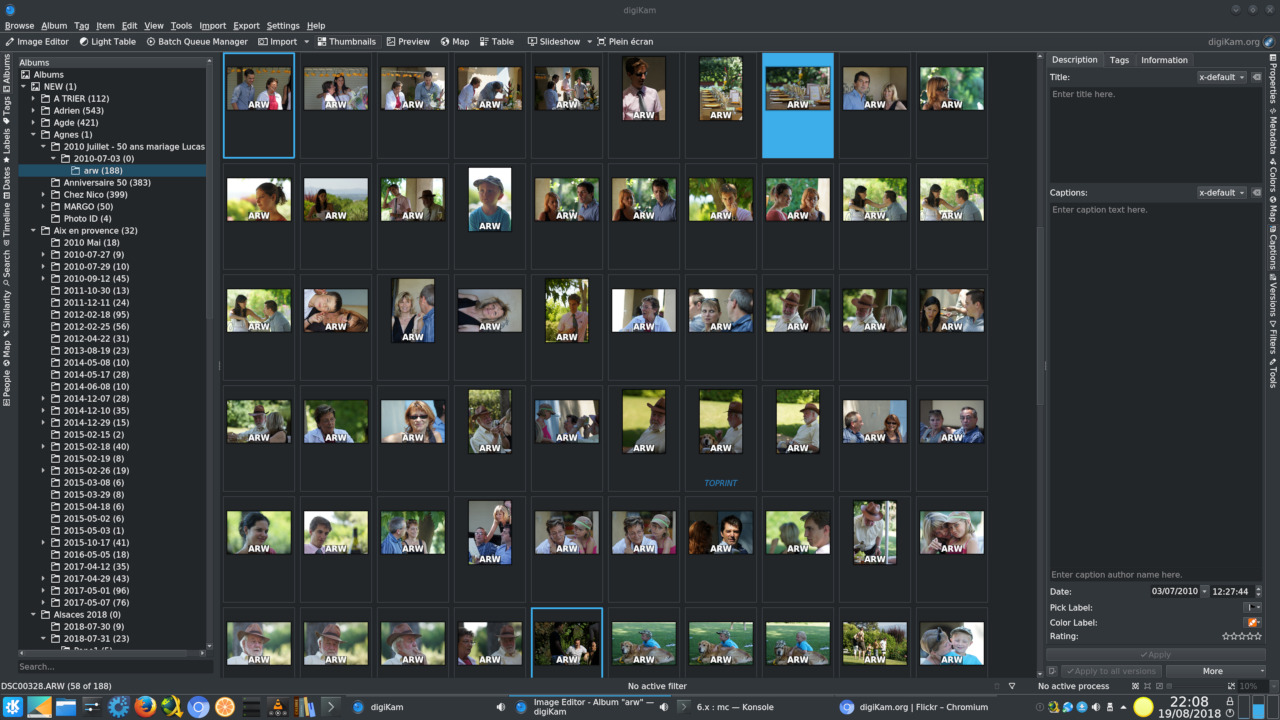
So the XMP file darktable-cli uses isn't up-to-date and I won't see the changes happen live in Inkscape. Sadly though, my first attempt which was to have an Inkscape window with my clipped picture, a darktable window to further adjust it as I watched the end result in Inkscape and a shell to run darktable-cli failed miserably, because the changes I make interactively in darktable aren't saved to the XMP file immediately. I soon saw myself adding darktable commands to a makefile to fix a picture I had included into an Inkscape file which then clips it. I particularly admire the choice of offering a darktable CLI, which makes fitting it into a workflow possible. However, next time I started darktable, not only were the changes still there the XMP file came back! It turns out darktable keeps the same change information inside SQLite databases under ~/.config/darktable, sadly making the interaction fuzzy and rather unusable. The purpose of these XMP files is actually unclear, and I realised as much so when I once removed one of them with the hope to reset some changes in a picture. The XMP files are simply XML files, which I thought was a good idea at first, until I tried changing values in there manually I soon realised they were rather obscure and that I couldn't quickly get away with it without using the graphical user interface. I was pleased to hear that darktable will never touch the original photo, but will record any changes in a so-called sidecar XMP file. For ignorant would-be photographs such as myself, the developers added the nice touch of grouping the modules, and one of them is called basic group, meaning somebody like me will find most of what they need in there. There are many modules coming with darktable, and I content myself with using only a minute fraction of them.

Pulling on the ends of a histogram is often all it takes to give a photo a stunning look But the results on my pictures are staggering. The widget may not always be comfortable to use, especially when I need to pull the histogram rather far, causing the mouse to drop off it, stopping the control and forcing me to pull again from a different point. The first thing I do each time I load a picture is to adjust the exposure histogram simply by pulling it left and right. In fairness, it may take with a pinch of salt the path to a specific file I'm giving it and will just satisfy itself loading all the pictures in the same directory as the last one I passed. I will be able to give it as argument a directory or a list of photos. While darktable offers a so-called lighttable to organise, tag, sort and filter my photos, it doesn't pretend to be an end-to-end photo manager. And that's possibly also thanks to the ease of use of darktable.
DIGIKAM ONLY ONE TOOL AT A TIME HOW TO
One of these brought me up to speed: in a matter of half an hour, I knew how to give my photos a quality I never thought I could. If I couldn't find a getting-started guide from the darktable website, only more of a reference manual, I found that the community is sufficiently enthusiastic to provide video tutorials. They say darktable is the tool of choice for people who are familiar with Adobe Lightroom – which I wasn't either, but I did see what other people do with it and I liked it. My first serious experience with raw photo editing was darktable, and I was immediately impressed. I've got a hierarchical filesystem, where I can give files and directories names and which I can work with using convenient and standard UNIX commands. It shouldn't intrusively try to manage my pictures.It has to provide the interface to make raw photo processing seamlessly fit in my workflow, which will involve other tools ranging from vector graphics programs such as Inkscape to makefiles to apply corrections noninteractively once interactively defined.Click there and make it look right, sort of thing. It has to help me make my photos look good without too much photo and image processing knowledge.

In my particular use case, this means three things:

I was looking for a raw editor which could help me process and make use of my pictures quickly. A review of raw photo editors by somebody who doesn't know much about photos, for somebody who doesn't know much about photos, but does know their UNIX.


 0 kommentar(er)
0 kommentar(er)
